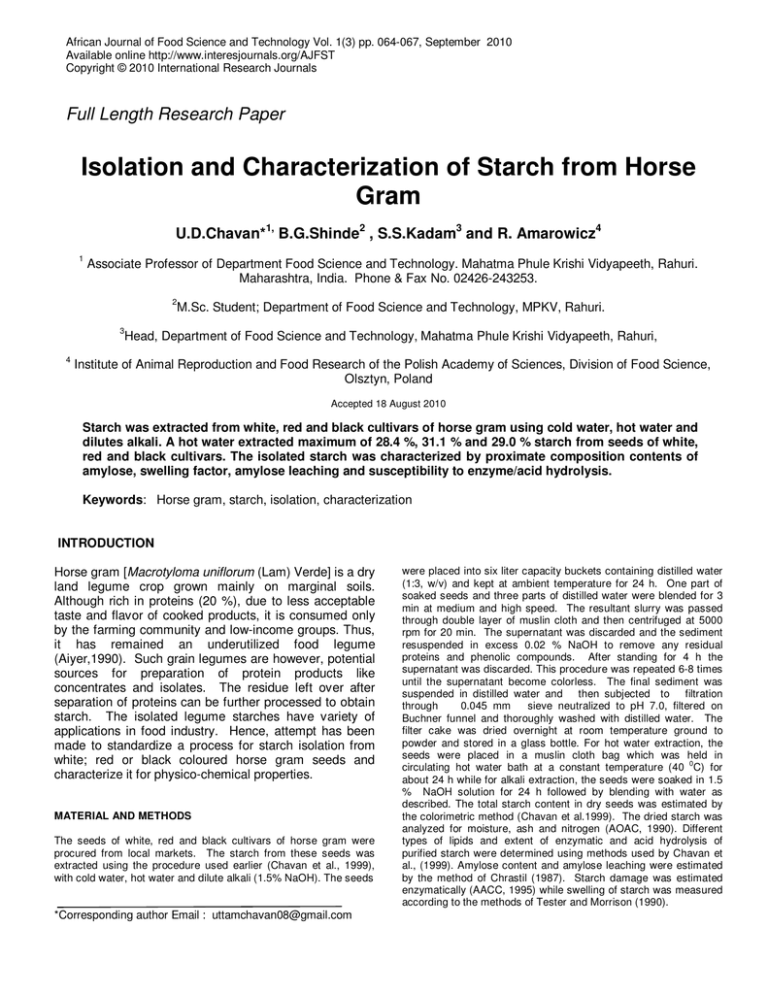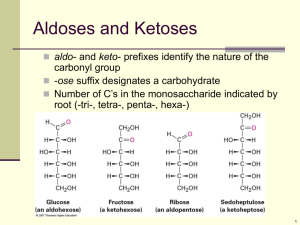Document 14105984
advertisement

African Journal of Food Science and Technology Vol. 1(3) pp. 064-067, September 2010 Available online http://www.interesjournals.org/AJFST Copyright © 2010 International Research Journals Full Length Research Paper Isolation and Characterization of Starch from Horse Gram U.D.Chavan*1, B.G.Shinde2 , S.S.Kadam3 and R. Amarowicz4 1 Associate Professor of Department Food Science and Technology. Mahatma Phule Krishi Vidyapeeth, Rahuri. Maharashtra, India. Phone & Fax No. 02426-243253. 2 M.Sc. Student; Department of Food Science and Technology, MPKV, Rahuri. 3 Head, Department of Food Science and Technology, Mahatma Phule Krishi Vidyapeeth, Rahuri, 4 Institute of Animal Reproduction and Food Research of the Polish Academy of Sciences, Division of Food Science, Olsztyn, Poland Accepted 18 August 2010 Starch was extracted from white, red and black cultivars of horse gram using cold water, hot water and dilutes alkali. A hot water extracted maximum of 28.4 %, 31.1 % and 29.0 % starch from seeds of white, red and black cultivars. The isolated starch was characterized by proximate composition contents of amylose, swelling factor, amylose leaching and susceptibility to enzyme/acid hydrolysis. Keywords: Horse gram, starch, isolation, characterization INTRODUCTION Horse gram [Macrotyloma uniflorum (Lam) Verde] is a dry land legume crop grown mainly on marginal soils. Although rich in proteins (20 %), due to less acceptable taste and flavor of cooked products, it is consumed only by the farming community and low-income groups. Thus, it has remained an underutilized food legume (Aiyer,1990). Such grain legumes are however, potential sources for preparation of protein products like concentrates and isolates. The residue left over after separation of proteins can be further processed to obtain starch. The isolated legume starches have variety of applications in food industry. Hence, attempt has been made to standardize a process for starch isolation from white; red or black coloured horse gram seeds and characterize it for physico-chemical properties. MATERIAL AND METHODS The seeds of white, red and black cultivars of horse gram were procured from local markets. The starch from these seeds was extracted using the procedure used earlier (Chavan et al., 1999), with cold water, hot water and dilute alkali (1.5% NaOH). The seeds *Corresponding author Email : uttamchavan08@gmail.com were placed into six liter capacity buckets containing distilled water (1:3, w/v) and kept at ambient temperature for 24 h. One part of soaked seeds and three parts of distilled water were blended for 3 min at medium and high speed. The resultant slurry was passed through double layer of muslin cloth and then centrifuged at 5000 rpm for 20 min. The supernatant was discarded and the sediment resuspended in excess 0.02 % NaOH to remove any residual proteins and phenolic compounds. After standing for 4 h the supernatant was discarded. This procedure was repeated 6-8 times until the supernatant become colorless. The final sediment was suspended in distilled water and then subjected to filtration through 0.045 mm sieve neutralized to pH 7.0, filtered on Buchner funnel and thoroughly washed with distilled water. The filter cake was dried overnight at room temperature ground to powder and stored in a glass bottle. For hot water extraction, the seeds were placed in a muslin cloth bag which was held in circulating hot water bath at a constant temperature (40 0C) for about 24 h while for alkali extraction, the seeds were soaked in 1.5 % NaOH solution for 24 h followed by blending with water as described. The total starch content in dry seeds was estimated by the colorimetric method (Chavan et al.1999). The dried starch was analyzed for moisture, ash and nitrogen (AOAC, 1990). Different types of lipids and extent of enzymatic and acid hydrolysis of purified starch were determined using methods used by Chavan et al., (1999). Amylose content and amylose leaching were estimated by the method of Chrastil (1987). Starch damage was estimated enzymatically (AACC, 1995) while swelling of starch was measured according to the methods of Tester and Morrison (1990). Chavan et al. 065 Table 1. chemical composition (%) and some properties of starches of white, red and black cultivars of horse gram Parameter White Red Black Total starch 45.0 ± 1.50 47.5 ±1.60 45.1 ± 1.50 a. Cold water 23.13 ± 0.65 26.43 ± 0.75 22.03 ± 0.50 b. Hot water 28.43 ± 0.70 31.10 ± 0.75 29.00 ± 0.57 c. Alkali solution 26.56 ± 0.83 28.13 ± 0.16 26.00 ±0.45 Moisture 10.20 ± 0.16 12.00 ± 0.61 9.63 ±0.81 Ash 0.07 ± 0.01 0.08 ± 0.01 0.08 ± 0.01 Nitrogen 0.05 ± 0.01 0.04 0.01 0.06 ± 0.02 a. Surface lipids 0.05 ± 0.01 0.04 ± 0.01 0.04 ± 0.01 b. Bound lipids 0.10 ± 0.02 0.10 ± 0.01 0.13 ± 0.01 c. Total lipids 0.15 ± 0.02 0.14 ± 0.02 0.17 ± 0.02 Amylose 35.50 ± 0.80 34.00 ± 1.30 36.30 ± 1.40 Starch damage 3.55 ± 0.80 3.78 ± 0.60 4.20 ± 0.50 Starch yield Lipids RESULTS AND DISCUSSION by red (3.8 %) and white (3.5 %) cultivar starches. Yield and chemical composition Swelling factor and amylose leaching The total starch content in white, red and black cultivars of horse gram was 45.5, 47.4 and 45.1 %, respectively when determined colorimetrically (Table 1). The yield of isolated starch from white, red and black cultivars of horse gram was 23, 26 and 22 %, respectively for cold water and 28, 31 and 29 % for hot water while it was 27, 28 and 26 % for alkali treatment, respectively (Table 1). The nitrogen content of purified starches was in the range 0.04 to 0.06 %, indicating the absence of endosperm proteins and by implication, most of the non-starch lipids. The nitrogen content of isolated starches represents the contributions from endosperm storage proteins, lysophospholipids and proteins located inside starch granules. The total lipids (0.14 to 0.17 %) obtained by acid hydrolysis (Table 1) of the horse gram starches mainly represent free and bound starch lipids. The total amylose content ranged from 34.00 to 36.30 %. The extent of starch damage during wet blending was high and pronounced in black cultivar starch (4.2 %) followed Swelling factor and amylose leaching were investigated over the temperature range 50-95 0C. The swelling factor followed the order black > red > white cultivar starches (Table 2). However, the amylose leaching was found more or less same at all the stages of temperature except at the starting temperature (70 and 80 0C). The present values for swelling factor and amylose leaching are within the range reported for other legume starches (Hoover and Manuel, 1996). The observed values of swelling factor suggest that bound lipid content (Table 1) is not a factor influencing granule swelling. It is likely that interactions between amylose chains within the amorphous domains of the granule (these interactions would reduce hydration of amylose chains) negate or nullify the influence of bound lipids on granular swelling. The results indicated that the swelling factor percentage increased rapidly above 80 0C. and also dramatic increase in amylose leaching was 0 0 found between 80 C and 95 C. The similarities in 066 Afr. J. Food Sci.Technol. 0 Table 2. sweling factor (%) and amylose leaching (%) of horse gram starch at different temperature ( c) Tempera0 Ture ( C) Swelling factor (%) Amylose leaching (%) White Red Black White Red Black 50 2.01±0.13 2.85±0.15 2.98±0.18 - - - 60 2.95±0.34 3.13±0.36 3.43±0.30 - - - 70 6.30±0.32 5.93±0.20 6.20±0.37 8.00±0.32 6.10±0.14 7.00±0.24 80 12.33±0.32 11.58±0.28 11.73±0.46 9.46±0.60 7.00±0.12 9.40±0.80 85 13.70±0.60 13.06±0.20 13.10±0.61 11.80±0.45 11.20±0.23 90 17.26±0.70 18.00±0.57 17.66±0.95 13.60±0.41 13,30±0.57 95 24.70±0.53 25.00±0.70 25.73±1.06 15.30±0.32 15.90±0.57 12.30±1.1 7 13.80±0.6 8 15.40±0.3 swelling factor (Table 2) in all three horse gram starches suggest that the degree of crystalline packing within starch granules of all the three cultivar starches are probably of a higher order of magnitude (Hoover and Manuel, 1995). Enzymatic hydrolysis From the results, it is apparent that red cultivar starch is a better substrate than white and black cultivar starch, undergoing 47.66% hydrolysis by porcine pancreatic αamylase within 24 h as compared to 43.3 and 43.3%, respectively (Figure 1). Furthermore, the rate of increase in hydrolysis during 24 h period was more pronounced in red cultivar starch than in other two cultivar starches. The low level of surface lipids (<0.05%) and nitrogen (<0.06%) suggest that they are not significant factors in restricting the absorption of α-amylase at the site of fixation of the granule surface. The present results of enzymatic hydrolysis of horse gram starches are concurrent with the results reported for other legume starches (Hoover and Manuel, 1996). Acid hydrolysis The hydrolysis of white, red and black cultivar horse gram starches by 2.2 N HCl showed a two stage solublization pattern. A relatively higher rate was observed during first 12 days, followed by a lower rate between 12 and 20 th days. At end of 12 day, the white, red and black cultivar starches were hydrolyzed upto 28, 32 and 31% , respectively (Figure 2). These values were comparable with for other legume starches (Hoover and Manuel, 1995; Hoover and Manuel, 1996). The rate of increase in th hydrolysis beyond 12 day may be corresponding to degradation of the crystalline region (Carins et al., 1990). At the end of day 20, white, red and black cultivar starches were hydrolyzed upto 35.6, 40.6 and 36.8%, respectively. The black cultivar starch should have been hydrolyzed to a less extent than other two cultivar starches due to its higher bound lipid content (0.13%) as against 0.10 % for white and red cultivar starch (Table 1). However, the observed extent of hydrolysis was red > black > white cultivar. This suggests that this difference in hydrolysis may be mainly influenced by the magnitude of the interaction between amylose chains, within the amorphous domains of the starch granule. It has been generally accepted that heterogeneous acid hydrolysis preferably attacks the more amorphous regions of the granule and the crystalline regions are less susceptible and are attacked only after a period of 8-12 days (Cairns et al., 1990). This is due to dense packing of starch chains within the starch crystallites and the high activation energy (Wu and Sarko, 1978) required changing the conformation of the glucose unit (within the starch crystallites) from a chair to a half chair form. (a prerequisite to acid hydrolysis). The increase in th hydrolysis beyond 12 day suggest that crystallites in white and black cultivar starches are tightly packed and/or are more in the number than in red cultivar starch. The results showed that the horse gram starches are more susceptible to enzyme than to acid hydrolysis. Similar findings have been reported for other legumes (Hoover and Manuel, 1996). REFERENCES AACC (1995). American Association of Cereal Chemists, Approved th Methods of AACC, 9 Edn. Vol. I and II. St. Paul. MI. th Aiyer, YN, (1990) Horse gram, In : Field Crops of India, 7 Edn. (Aiyer, Y.N.ED), Bangalore Press, Bangalore. pp.115-117. AOAC (1990) Association of Official Analytical Chemists. Official th Methods of Analysis, 15 Edn. Washington, DC. Cairns P, Leloup VM, Miles MJ, Ring SG, Morris VJ (1990) Resistant Chavan et al. 067 starch: An X-ray diffraction study into the effect of enzymatic hydrolysis on amylose gels in vitro. J. Cereal Sci. 12: 203-206. Chavan UD, Shahidi F, Hoover R, Parera C (1999) Characterization of beach pea (Lathyrus maritimus L.) starch. Food Chem. 65:61-70. Chrastil J. (1987) Improved calorimetric determination of amylose in starches of flours. Carbohydrate Research. 159 : 154-158. Hoover R, Manuel H (1995) . A comparative study of the physiochemical properties of starches from two lentil cultivars. Food Chem. 53 : 275-284 Hoover R, Manuel H(1996) Effect of heat moisture treatment on the structure and physico-chemical properties of legume starches. Food Res International 29: 731-750 Tester RF, Morrison WR (1990) Swelling and gelatinization of cereal starches. I. Effects of amylopectin, amylose and lipids. Cereal Chem 67: 551-557. Wu HCH, Sarko K (1978) The double helical molecular structure of Aamylose. Carbohydrate Research 61:27-31





